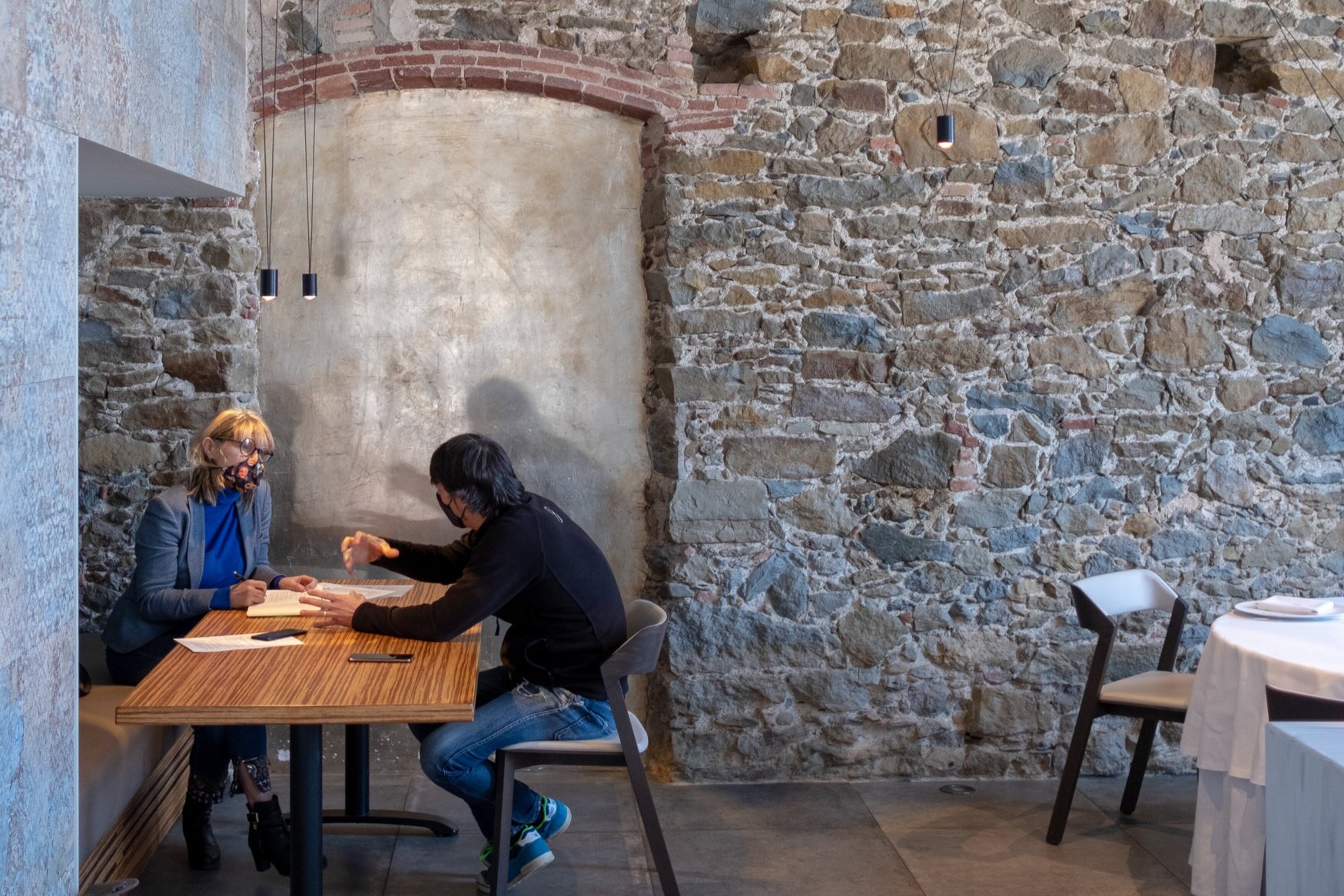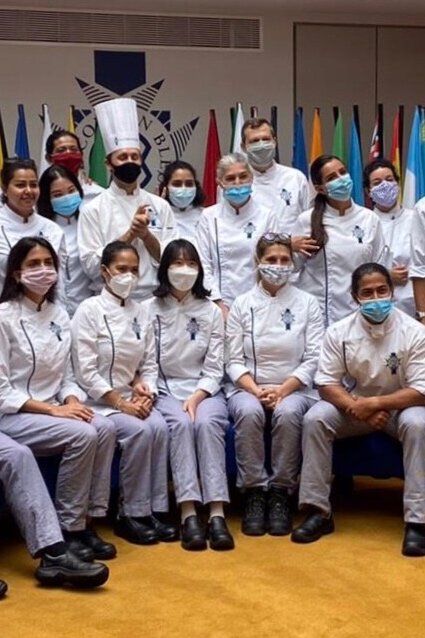A blue head - essay Financial Times
What can chefs, rugby players, pilots and entrepreneurs learn from each other? Staying calm when things seem to be going wrong. After thirty years of international business life, Sheila Struyck now works as Chef de Cuisine. She wonders how to prevent 'choking' or 'freezing', in an essay for the Financial Times. Here is a translation. FD - 11 September 2021
All the tables are booked, GaleriAAA is filling up. Murmurs and hopeful faces in the restaurant, everyone looks great. The guests are looking forward to a night out. I am on my own in the narrow, open kitchen. So narrow that the waiters and I 'dance' around each other like in choreography. With “behind you”, “hot” and “oven open” we warn each other where we are. The dishwasher is down, we'll do the washing up ourselves tonight. This summer, guests stay longer and expect a lot from the service. We’re also working with fewer people because staff are ill, in quarantine or on holiday.
At five o'clock, at the briefing, we discussed dietary requirements and special features to avoid surprises. It is going to be exciting. But bringing an evening like this to a successful conclusion is part of the fun. Everyone sits down to the antipasti at the same time. Some tables are still 'thinking about the next course'. The orders I already have are waiting in a pile on the right. When I know what a table wants, I can prepare the components for the main courses. In the order of operations to finish everything at the same time. If a table has 'ordered’, the receipt goes to the left. In this order, everything goes into the pan and to the table. So now I have little to do. Doing nothing makes a chef nervous. I get the idea that I am watching a car crash in slow motion. It's going wrong, this is going to cause delays, I can only do three tables at a time without ruining something.
Staying calm is a skill
“The toughest professions are teacher, chef and - ahem - doctor,” says the GP when asked if it is normal that I have to drink two litres of water during a shift. “Yes, the heat, the ventilation, the hard physical work and the stress completely dehydrate a person.” Even René Redzepi, the chef of Noma, the best restaurant in the world, writes in A Work in Progress (2013): “When you get to cook for someone you have always adored as a young chef, you get nervous and excited at the same time. These two things do not go well together in the kitchen. But if you stay calm, don't let your fear get the better of you and force yourself to have fun and enjoy every second, you can combine the two.”
After a long career in business, I became a chef at last. Staying calm when things go wrong, ignoring the negative voices in your head and continuing to perform as a team is a crucial skill not only in the kitchen, but also in a large company. How do chefs and other professionals deal with this?
illustration Jacob Stead
Fixed methods and no fear
Albert Sastregener, Chef of Bo.TiC, a two-star restaurant near Girona in Spain, says: “I did a dessert course twenty years ago. That put the microchip of a pastry chef in my head.” Cuisine and patisserie are separate worlds. One with big knives, fast strokes, fire and cooking by feeling, by tasting and the other of precision, colouring, scraping, gliding and baking by scale. The organisation and methods of innovation are particularly interesting. It takes us months to develop a new dish, with trial and error on the days we are not open. If it then appears on the menu, we make a laminated card. Then everyone has to follow the method exactly. Everything is weighed, down to the salt. Not only does Sastregener have a guaranteed quality, the people have 'procedures' to fall back on when something unexpected goes wrong. Sastregener does not want frightened people in its kitchen. During the monthly meeting I ask and receive feedback on how things can be improved. Fear is a bad adviser when the pressure is high’.
Cleaning
Chef Guillaume Siegler has repeated “Clean as you go” a thousand times at Le Cordon Bleu. You even get a mark for it every lesson. Of course, for hygiene-reasons, food poisoning is always something to be careful about. But also focus. An empty and clean workstation lets you work precisely, accurately and quickly. Everything that you see in your field of vision and that you are not working on is distracting. Just when the pressure is on and you're afraid you won't succeed, you have to stop and clean up. Two seconds of work, time to breathe, to get out of the situation.
Iolanda Bustos, the well-known Catalan Flower Chef believes that the time of getting angry and screaming is over. ‘You can work with the most sustainable products, but stressed or frightened people don't make beautiful dishes. The briefing before the service ensures that everyone knows what is going to happen. That prevents nervousness. And if something does go wrong, I stop the situation. Together with the staff member, I walk away from the problem. Take three deep breaths and smile. With this reset, the situation stops and you start again. If you continue to solve the problem, it will only get worse. Smiling relaxes you. Your neurons make contact and your environment responds more calmly. The emotion stays out of it’.
Red and blue
A heaving stadium at a penalty shootout in a final puts pressure on a player. An average evening in a restaurant kitchen comes pretty close. It is a long-awaited evening out. Guests have to get their food on time, the printer rattles off new orders and colleagues ask, while you have six pans on the stove, if there is lactose in the panna cotta. (“Yes, why do you think it's white, that's cream. Panna means cream.”) All sorts of things are happening around you.
“As a coach, I want to teach ‘composure’: under pressure, performing the things you can do flawlessly every training session. The same in a match, in emotion, in fatigue,” says Michiel Snijders, ex-rugby international and coach of the national student team and hands me Legacy by James Kerr, about the legendary All Blacks. In it, I read about red and blue. Red is 'the dark, the choke'. A negative spiral of self-criticism, rigidity, anger and panic. Blue is 'the light, the freedom,' a calm zone where you are in control and stay in the game.
By directing your attention, you control your thoughts, keep your emotions under control and improve your performance. How do the All Blacks keep their heads blue? First, find out what stimuli, sound, word or negative thought, put your head on red alert. Then choose an anchor, a physical 'mantra' that brings your attention to the penalty kick itself and not to the World Cup that depends on it. To the sizzle and the cooking of the redfish in the frying pan and not whether people are getting angry because they are waiting. Every All Black consciously chooses an action that works for him - hopping on his toes, pulling up his socks - and trains himself in doing this.
Reset
“Yes, that's the startle and surprise training. Slide your seat back, take a deep breath, tighten your arms and shoulders and relax again and ask your colleague how he’s doing,” explains Christiaan Soeteman, instructor on small and large aircraft and aviator. “This reset prevents the 'amygdala hijack', the initial emotional reaction: fight or flight. Chair back gives distance from the situation, deep breathing through the abdomen represses the intense emotion. Tensing and relaxing the muscles relaxes your body. Finally, check on your colleague to make sure you are not working on top of each other. All this takes fifteen seconds. You always have that time and you get it back more than once because afterwards you can perform the actions with focus.”
Chefs, All Blacks and pilots do more or less the same to keep calm when a crisis seems to be brewing. Anyway, practice a lot, do things in the same order every time. Learn a routine that you can do without error. Have a briefing before you start work. And does it go wrong, in real life or in your head? Pay attention to the task and not to the consequence, don't react but act. Take a step back. Do a reset with an anchor. Whether that is taking three breaths, taking a step back, smiling, tightening leg muscles or brushing. Then you remove yourself from the problem and start the solution. In business, do we practise difficult situations enough? And does 'the Chef' know how to keep a cool blue head?
The first tables are called by the staff. I consciously direct my attention to the actions I know so well. Once the parts of a dish are in the oven or the pan, I am sure they will reach a table. Taking three breaths when the printer starts spitting out more receipts. Keep smiling. Discussing with the waiters how things are going. At a flash of 'this is not going to work, stop and reset. Clean the worktop. Back to the pan. Just making sure that every bavette and cauliflower 'chicken-wing' is tender and delicious. The panic disappears, the blue appears. When all the tables have had their main course, to the guests to thank for their patience. That they had to wait a while is not as bad as not eating well. We drink a final beer satisfied after the long evening. No red heads here.
The Chefs featured in this essay
Verscheen als essay in Het Financieele Dagblad van 11 September 2021





